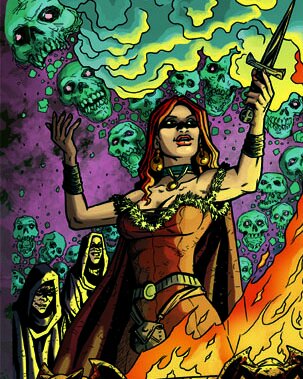Lady Macbeth's Breasts (SFW - honest!)
We're a week away from the release of the new JULIET trade to bookstores, and to help celebrate that we have something cool for you Shakespeare academics.Michelle Ephraim, who was one of the scholars who helped to put together our Backstage Edition has thoughtfully provided us with a copy of a Kill Shakespeare inspired essay, entitled, rather provocatively: Lady Macbeth's BreastsMichelle talks in her piece about the role that sexuality plays in the depictions of Lady M, both in our comic, and in culture as a whole. It's a funny, thought-provoking and insightful take on one of my favourite characters in the canon, as well as one that gives us a pat on the back for having Lady M transcend her "femme fatale" tropes (yay, us!).It's a short and enjoyable read - and you can go here to get in on the fun!Or if you'd rather just read the whole thing now i'ts here below: Lady Macbeth’s Breasts Before venturing into the influential (and notoriously censorious) Texas library market, the Kill Shakespeare team took some professional advice and gave Lady Macbeth’s ample breasts a bit of a nip/tuck. Especially to the “side boob” swelling out from the periphery of her metal tank top. Even with this strategic augmentation, Lady Macbeth’s breasts are a formidable presence in KS. And even more than her signature props—daggers, poison, wine—the breasts are Lady Macbeth’s most defining accessory. At the end of Issue #6 (also the concluding chapter of Kill Shakespeare: Volume 1), Lady Macbeth is serving up plenty of wine and cleavage to her obsequious paramour, Iago. (You can practically hear him panting.) Issue #7, with which Kill Shakespeare: Volume 2 begins, picks up with the same tableau of booze and breasts, establishing the latter as a key visual and symbolic theme in KS’s grand design. These prominent breasts seem appropriate given Kill Shakespeare’s literary context. In Shakespeare, Lady Macbeth’s most famous speech, her furious response to Macbeth when he tries to renege on their plan to murder King Duncan, concerns this part of her anatomy: I have given suck, and knowHow tender ’tis to love the babe that milks me.I would, while it was smiling in my face,Have plucked my nipple from his boneless gumsAnd dashed the brains out, had I so sworn as youHave done to this. (1.7) The speech has launched many an academic publication on Lady Macbeth’s maternal history. Did she give birth? What happened to the kid? Regardless of the true story of little Macbeth, her anecdote is meant as a testimony to her toughness, her refusal to wuss out of any promise. Ultimately and ironically in Act I of Macbeth, Lady Macbeth cites the female breast to articulate her strong masculine attributes and, by contrast, her husband’s weak, feminine nature. We hear her plea to be rid of any and all nurturing attributes: “Come you spirits/Unsex me now, and take my milk for gall.” Just in the highly unlikely case there’s a residual drop of motherly compassion. But her real concern lies with her husband who’s “too full of the milk of human kindness.” Whereas she’s manned-up to the task of killing the king and usurping the throne, Macbeth has not; she must bully him into it. To this end, Lady Macbeth shames her husband: if he refuses the chance to kill Duncan he is unmanly, but if he takes this opportunity he will be “so much more the man.” Shakespeare’s Lady Macbeth demonstrates her feminine side by the end of the play, but it’s not a pretty sight. Senseless, sleepwalking, and suicidal, she embodies what contemporary medical discourse would have identified as textbook female hysteria. Modern American psychiatrist Isador Henry Coriat in his 1912 book The Hysteria of Lady Macbeth goes to town with this interpretative tradition: “Lady Macbeth is a typical case of hysteria; her ambition is merely a sublimation of a repressed sexual impulse, the desire for a child based upon the memory of a child long since dead” (28-9). KS, however, clears Lady Macbeth of any trace of maternal trauma or desire. She’s homicidal, not hysterical. She’s characterized by malevolence, not madness.[1] In gaining and maintaining the Scottish throne, she also succeeds where her Shakespearean prototype fails, but this is hardly enough for her. And unlike Shakespeare’s Lady Macbeth, she doesn’t rely on her husband to get what she wants; she simply rids herself of Macbeth, a nuisance of a husband and an obstacle to her own political ambitions. In fact, KS’s Scottish Queen doesn’t give her husband much thought at all. It’s Iago who comments on their inverted gender roles: “[Lady Macbeth] has none of the soft parts of her husband.” No soft parts, indeed. Those impressively pneumatic breasts are definitely not filled with milk, not even a drop of it. Instead of milk, she’s full of the sinister liquids of liquor and poison, which she administers without a trace of human kindness. Lady Macbeth’s breasts in KS might be seen as inflated, metaphorically, with her voracious ambition. Appropriately, they are also her most formidable weapon, insuring her husband’s lusty oblivion as she straddles him in bed . . . and murders him. Instead of drinking the “nectar” between her legs as he happily expects, he gets poison thrust down his throat. As Lady Macbeth forces her liquid into him with her phallic vial, she is so much more the man. Like the stage and film productions that have depicted Lady Macbeth erotically, KS emphasizes a connection between a woman’s verbal and sexual aggressiveness. In the Renaissance, the oft-open mouth of a woman who talked excessively or forcefully was thought to have an analogous “openness” in her nether regions as well. In KS, Lady Macbeth’s skill at verbal manipulation hooks not only her husband, but Iago and King Richard II. In bed, she and Richard spar with “wit”--a word that for Shakespeare’s audience would have a double entendre as genitalia. Like their battle of wits, their competition for Shakespeare’s quill, an object with clear phallic symbolism throughout KS, is ultimately a fight for sexual and political domination. The most audacious adaptation of Lady Macbeth’s character in KS, more than her inspired cup size, is her new identity as a bona fide witch. Her magical cred supersedes that of the incanting Weird Sisters who submissively mumble their toil and troubles in her shadow.No matter how many Shakespearean scholars have argued for their similarities in Macbeth, there is no evidence that Shakespeare’s Lady Macbeth knows the three Weird Sisters, save for Macbeth’s mention of them. In Shakespeare’s tragedy, all four ladies may take gratification in controlling Macbeth, but only the witches have true agency; as she discovers, Lady Macbeth is just a poor player strutting and fretting her way to a really crappy fate. By promoting Lady Macbeth to witch status, KS ups the ante of the threat she poses to Macbeth, to Shakespeare, and, if we think about King James’ influential 1597 treatise on witchcraft, Demonologie, to the world of men in general. Richard is warned that she is “bewitching” and to “stay safe from her spells,” but he counters that she is merely his “possession, nothing more.” Nothing more, Richard? Are you sure about that? Shakespeare’s witches are sexual deviants who gets their kicks from screwing with men. Maybe from literally screwing them, too. They brag about removing a sailor’s thumb, a castration narrative KS evokes in Lady Macbeth’s fantasy of snatching the quill from Shakespeare. A well-endowed caricature of a Sexy Woman, Lady Macbeth would evoke a grotesque and subversive (and transgendered?) figure should she gain possession of the phallic quill, that penile appendage. With the quill, she would, as she declares to Richard, be “crowned king of this infinite space.” In Demonologie, King James’ deep paranoia about his subjects’ loyalty is on full display. He writes that women are susceptible to becoming “entrapped” by the “gross snares of the Devil” because they are weak, frail, disloyal creatures by nature. Once they become witches, the devil’s servants, they will launch a sexual and thus, political assault on every man they can get their hands on. Witches, he argues, have the power to:“[weaken] the nature of some men, to make them unable for women.” Unlike the bearded ugly witches in Shakespeare’s play, the extreme sexuality and physical beauty of KS’s Lady Macbeth only underscores, by contrast, the potentially sterilizing, castrating, and generally emasculating effects she has on men. What would King James make of her controlling the dagger that flies around trying to stab Hamlet and Shakespeare? Like the phallic vial of poison, the dagger is a weapon that is both physically and ideologically threatening in its symbolic usurpation of phallic power. It’s easy (and pleasurable) to imagine King James quaking with anger and pointing a shaky finger at this comic book Lady Macbeth. “See?,” he would mutter through clenched teeth, “I told you so!” At the end of Issue #12, after the big fight scene, Lady Macbeth disappears in a puff of magic smoke. It’s her own version of “I’ll be BAAACK.” Suddenly, that visually arresting eye candy of a body is gone, and we are left with . . . well, with eyes. Her eyes, staring out at us from the page. There is no body here, no breasts. Yet their gapingly absent presence is as much of a threat as they are, in all their gloriously visible cleavage, to the horny Iago. Shakespeare’s suicidal Scottish Queen becomes undone by her physicality—she just can’t seem to get that damn spot off her little hand. Not to mention the trauma of that lost child, the pet theory of Coriat and other psychoanalytic critics. There’s nothing little about Lady Macbeth’s character in Kill Shakespeare, but her enormous breasts, and perhaps her entire body itself, is a ruse. As the disembodied eyes suggest, she maintains a purely utilitarian relationship with her own body. Her real power isn’t her well-endowed physique but rather her ability to deploy it and collapse it. In this sense, her magic allows her to transcend the physical body, freeing her from the matters of flesh and blood—such as the prophecy of Banquo’s children who will succeed the childless Macbeths—that sunk her sixteenth-century prototype. Michelle EphraimAssociate Professor of EnglishWorcester Polytechnic Institute
In Shakespeare, Lady Macbeth betrays a soft spot early on: she says she won’t kill King Duncan because he resembles her father. On the other hand, a reader could imagine
KS
’s Lady Macbeth nonchalantly offing a family member should she get the chance.

